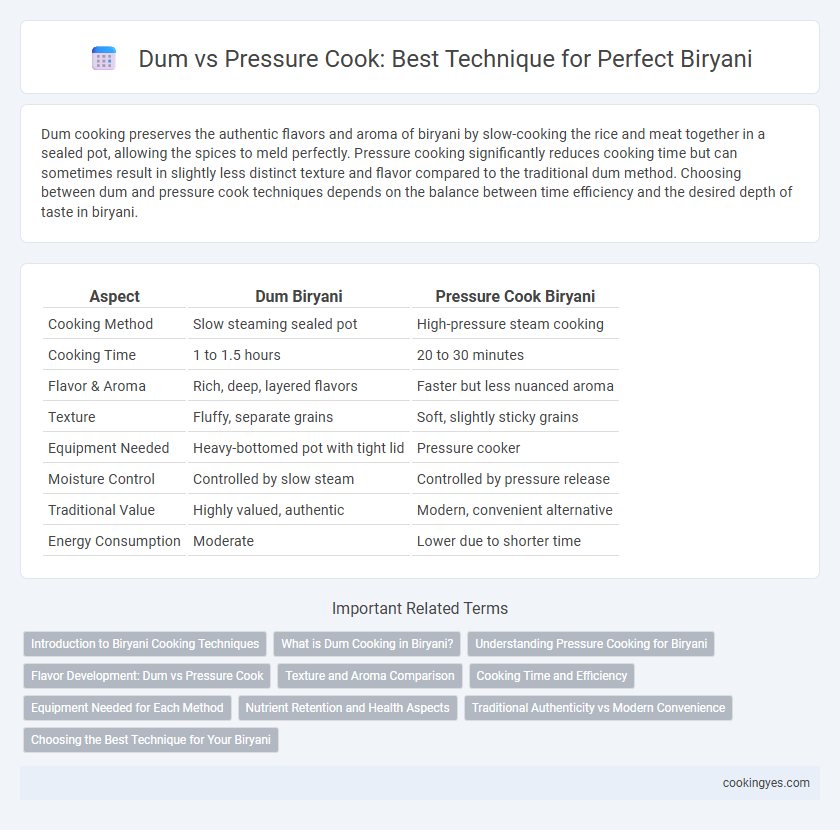Dum cooking preserves the authentic flavors and aroma of biryani by slow-cooking the rice and meat together in a sealed pot, allowing the spices to meld perfectly. Pressure cooking significantly reduces cooking time but can sometimes result in slightly less distinct texture and flavor compared to the traditional dum method. Choosing between dum and pressure cook techniques depends on the balance between time efficiency and the desired depth of taste in biryani.
Table of Comparison
| Aspect | Dum Biryani | Pressure Cook Biryani |
|---|---|---|
| Cooking Method | Slow steaming sealed pot | High-pressure steam cooking |
| Cooking Time | 1 to 1.5 hours | 20 to 30 minutes |
| Flavor & Aroma | Rich, deep, layered flavors | Faster but less nuanced aroma |
| Texture | Fluffy, separate grains | Soft, slightly sticky grains |
| Equipment Needed | Heavy-bottomed pot with tight lid | Pressure cooker |
| Moisture Control | Controlled by slow steam | Controlled by pressure release |
| Traditional Value | Highly valued, authentic | Modern, convenient alternative |
| Energy Consumption | Moderate | Lower due to shorter time |
Introduction to Biryani Cooking Techniques
Dum cooking in biryani involves slow steaming rice and marinated meat together in a sealed pot, allowing flavors to meld over low heat and resulting in a rich, aromatic dish. Pressure cooking, on the other hand, accelerates this process by using high pressure and temperature, significantly reducing cooking time while tenderizing the meat and infusing spices rapidly. Both methods offer distinct textures and flavor profiles, with dum preserving traditional layered taste and pressure cooking providing convenience without compromising essence.
What is Dum Cooking in Biryani?
Dum cooking in biryani is a traditional slow-cooking technique where marinated meat and partially cooked rice are sealed in a heavy-bottomed pot, typically sealed with dough to trap steam and flavors. This method allows the ingredients to cook slowly over low heat, ensuring the spices, aroma, and moisture are evenly absorbed, resulting in a rich and layered taste. The gradual infusion of steam preserves the texture of the rice and tenderizes the meat, making dum biryani distinct from pressure-cooked varieties that use high heat and shorter cooking times.
Understanding Pressure Cooking for Biryani
Pressure cooking for biryani accelerates the cooking process by using high steam pressure, which ensures the rice and meat cook evenly and retain moisture. This method reduces cooking time significantly compared to traditional dum cooking, making it ideal for busy kitchens without compromising flavor. Optimal pressure cooking requires careful timing and heat control to avoid overcooked textures and maintain the distinct layers characteristic of authentic biryani.
Flavor Development: Dum vs Pressure Cook
Dum cooking enhances biryani flavor by slow-cooking rice and meat in sealed pots, allowing spices and aromas to intensify and meld deeply over time. Pressure cooking speeds up the process but can lead to less nuanced flavors as the rapid cooking prevents full infusion of spices. For rich, complex taste profiles, the traditional dum technique is preferred over pressure cooking.
Texture and Aroma Comparison
Dum cooking enhances biryani's texture by allowing rice grains to remain separate and fluffy, while infusing deep, layered aromas through slow steam cooking. Pressure cooking speeds up the process but often results in denser, less distinct grains and a less nuanced flavor profile due to rapid heat exposure. For an authentic biryani experience, dum technique is preferred as it preserves delicate textures and rich, aromatic complexity.
Cooking Time and Efficiency
Dum cooking for biryani involves slow steaming for 45-60 minutes, allowing flavors to meld deeply and rice to cook evenly with tender meat. Pressure cooking significantly reduces cooking time to about 20-25 minutes by using high steam pressure, making it more efficient for quick preparation. While pressure cooking saves time, dum cooking preserves texture and aroma, preferred for authentic biryani taste.
Equipment Needed for Each Method
Dum biryani requires a heavy-bottomed pot or handi with a tight-fitting lid to trap steam and slow-cook the rice and meat, ensuring rich, layered flavors. Pressure cook biryani demands a pressure cooker with a secure sealing lid to cook ingredients quickly under high pressure, significantly reducing cooking time. Each method's equipment directly influences the texture, aroma, and depth of the biryani.
Nutrient Retention and Health Aspects
Dum cooking preserves more nutrients in biryani by slow-cooking sealed ingredients, minimizing nutrient loss and enhancing flavor through steam retention. Pressure cooking, while faster, can cause higher nutrient degradation due to intense heat and pressure, potentially reducing vitamins like B-complex and antioxidants. For health-conscious individuals, dum biryani offers superior nutrient retention and promotes better digestion by maintaining the integrity of spices and ingredients.
Traditional Authenticity vs Modern Convenience
Dum cooking preserves the traditional authenticity of Biryani by slow-cooking rice and meat over low heat, allowing flavors to deeply infuse and retain moisture for a rich, aromatic texture. Pressure cooking offers modern convenience by significantly reducing cooking time while maintaining tenderness, though it may compromise the layered texture and subtle flavor development intrinsic to classic Biryani. Choosing between dum and pressure cook methods depends on balancing the desire for authentic taste with the need for efficiency in preparation.
Choosing the Best Technique for Your Biryani
Dum cooking preserves the authentic aroma and texture of biryani by slow-cooking sealed pots over low heat, allowing flavors to meld gradually. Pressure cooking offers a faster alternative, significantly reducing cooking time while still tenderizing meat and rice effectively but may sacrifice some depth of flavor. For the best balance of taste and texture, Dum is preferred for traditional, richly layered biryanis, while pressure cooking suits quick meals without compromising too much on quality.
Dum vs Pressure Cook for Biryani technique Infographic

 cookingyes.com
cookingyes.com